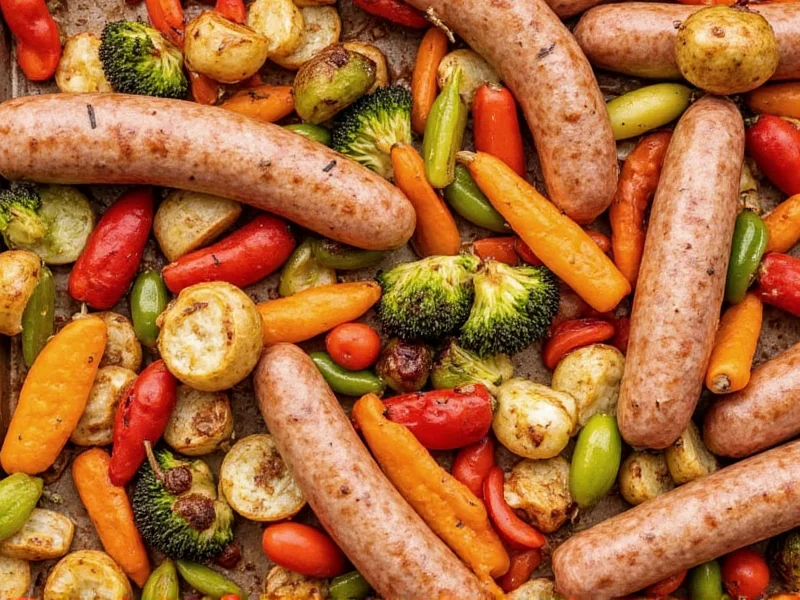A sausage and veggies sheet pan dinner represents one of the most efficient approaches to healthy, flavorful cooking. By combining quality sausage with seasonal vegetables on a single baking surface, home cooks achieve restaurant-quality results with minimal effort and cleanup. The high, dry heat of the oven creates the perfect environment for caramelization while ensuring even cooking throughout.
Why Sheet Pan Cooking Works for Sausage and Vegetables
Sheet pan cooking leverages convection heat to roast ingredients evenly while developing complex flavors through the Maillard reaction. When sausage and vegetables share the same pan, the fat rendered from the sausage bastes the vegetables naturally, enhancing flavor without added oils. The key scientific principle at work is that dry heat above 300°F (150°C) triggers caramelization in vegetables while rendering sausage fat for crisp exteriors and juicy interiors.
Professional chefs favor this technique because it requires no specialized equipment beyond a standard rimmed baking sheet. The method works particularly well with sheet pan sausage dinner recipes as the sausage's natural fats create a self-basting environment while the vegetables absorb those flavorful drippings.
Essential Components for Perfect Sheet Pan Sausage Meals
Selecting the right ingredients makes the difference between an average and exceptional sheet pan sausage and vegetables bake. Consider these guidelines when planning your meal:
| Ingredient Category | Recommended Options | Avoid |
|---|---|---|
| Sausage Types | Italian sausage, kielbasa, chicken apple sausage, chorizo, vegan sausage links | Fresh sausage patties, highly processed sausages with fillers |
| Vegetable Selection | Broccoli florets, bell peppers, red onions, cherry tomatoes, asparagus, zucchini | Leafy greens, watery vegetables like cucumbers |
| Fats & Oils | Avocado oil, olive oil, ghee | Butter (burns at high temps), low smoke point oils |
| Seasonings | Fresh herbs, garlic powder, onion powder, smoked paprika, lemon zest | Excessive salt (sausage is already seasoned) |
Step-by-Step Sheet Pan Sausage and Veggies Preparation
Follow these professional techniques for flawless results every time you make sheet pan sausage dinner with roasted vegetables:
- Prep your sheet pan: Line a rimmed baking sheet with parchment paper for effortless cleanup. Avoid dark-colored pans which can cause over-browning.
- Prepare ingredients: Cut vegetables into uniform 1-inch pieces. Slice sausage into 1-inch rounds or leave whole depending on type.
- Season properly: Toss vegetables with 1-2 tablespoons oil, salt, and seasonings. Arrange in single layer with space between pieces.
- Position sausage: Place sausage pieces among vegetables, ensuring they don't touch each other or the pan edges.
- Roast at proper temperature: Bake at 400°F (200°C) for 20-25 minutes, flipping halfway through cooking.
- Finish with freshness: Remove from oven when sausage reaches 160°F internal temperature and vegetables show caramelized edges.
Avoiding Common Sheet Pan Cooking Mistakes
Even experienced cooks make these errors when preparing easy sausage and vegetable sheet pan dinners:
- Overcrowding the pan: When ingredients touch, they steam rather than roast. Use two pans if necessary for proper air circulation around your sheet pan sausage and vegetables.
- Incorrect temperature: Below 375°F won't achieve proper caramelization; above 425°F risks burning sausage fat. The ideal sheet pan sausage dinner temperature is 400°F.
- Not flipping ingredients: Turn both sausage and vegetables halfway through cooking for even browning on all sides.
- Adding delicate vegetables too early: Add cherry tomatoes or asparagus during the last 10 minutes to prevent overcooking.
Variations for Different Dietary Needs
One of the strengths of this sheet pan sausage and veggies recipe is its adaptability. Consider these modifications:
- Gluten-free sausage and veggies sheet pan: Most quality sausages are naturally gluten-free, but always verify labels. Pair with root vegetables like sweet potatoes and parsnips.
- Low-carb version: Focus on non-starchy vegetables like broccoli, cauliflower, and bell peppers with chicken or turkey sausage.
- Vegan adaptation: Use plant-based sausage alternatives with extra mushrooms and eggplant for meaty texture.
- Meal prep friendly: This sheet pan sausage dinner with roasted vegetables stores exceptionally well for 3-4 days in airtight containers.
Storage and Reheating Guidelines
Proper storage maintains the quality of your sheet pan sausage and vegetable bake:
- Cool completely before storing in airtight containers
- Refrigerate for up to 4 days or freeze for up to 3 months
- Reheat in oven at 350°F for best texture (5-10 minutes)
- Air fryer reheating works well for restoring crispness (3-5 minutes at 375°F)
- Avoid microwaving which makes sausage rubbery and vegetables soggy
Perfect Pairings for Your Sheet Pan Meal
Complete your sheet pan sausage dinner with these simple additions:
- Fresh arugula salad with lemon vinaigrette
- Crusty whole-grain bread for soaking up flavorful drippings
- Simple grain pilaf using quinoa or farro
- Garlic herb compound butter melted over the finished dish











 浙公网安备
33010002000092号
浙公网安备
33010002000092号 浙B2-20120091-4
浙B2-20120091-4